South Africa (SA) still suffers from extreme social and economic inequalities, despite recording success in related areas such as fall in poverty rates, relatively steady economic growth and transitioning to democratic rule. The legacy of apartheid, a pre-democratic era which created a divide based on social stratification majorly along the lines of race and ethnicity, continues to be a determining factor of life opportunities for many South Africans. Patterns of poverty and inequality remain racialised. According to United Nations Development Programme, Black African households, which make up more than three-quarters of the national population, account for less than half of the country’s total annual household income. Further, World Bank’s inequality assessment report shows that about 47% of black households live below the poverty line while less than 1% of white households experience poverty. Inequality in SA occurs in various dimensions; therefore it is imperative to broaden the scope of analysis and understand the diverse components, such that all forms of inequalities and the structures that ingrain them are properly assessed to achieve tangible success.
Concept of inequality
A renewed focus on the problem of rising inequalities, and calls for social justice culminated in a dedicated Sustainable Development Goal (SDG) 10, which sets a target of reducing all forms of inequalities at both global and national levels. However, as a developmental challenge, inequality has varied meanings and interpretations, probably because it manifests in different forms such as economic, social and political domains. It could mean disparities in standard of living; examples are uneven income or wealth distribution and level of educational attainment. Another perspective is unequal access to resources, rights or representation as a result of social stratifications or individual circumstances.
The above views can be further explained using the theories of inequality of outcomes and opportunities. Inequality of outcomes relate to situations depicting unequal levels of achievements, with emphasis on noticeable disparities in the end-results recorded by individuals or countries. Whereas, inequality of opportunity stresses on the fairness of the processes that influence outcomes specifically, inferior opportunities and discriminations that prevent certain individuals or a segment of a population, from realising maximum achievements. These exclusions may be attributable to circumstances beyond an individual’s control, for instance race and ethnicity, gender or geographical location. Both theories are interdependent, and useful in determining the causes and extent of inequality, in order to devise appropriate policies to reverse the inequality trend. More importantly, it is the intersection between economic deprivation and social discrimination, that serve to define the most severe inequalities and often reinforce exclusion in societies.
Economic inequality in SA
Studies reveal a staggering gap between SA’s rich and poor. Figure 1 below shows that the income inequality trend has not changed much over the years. At 0.63, the GINI index suggests an uneven income distribution with most of the national income skewed towards a few citizens. In comparison with other upper-middle income countries, SA’s inequality is extremely high and unusual as shown in Figure 2. Similarly, Figure 3 reveals that the income of the country’s top 10% is seven times more than the income of the poorest 40% of the population. This position is clearly an outlier across the globe.


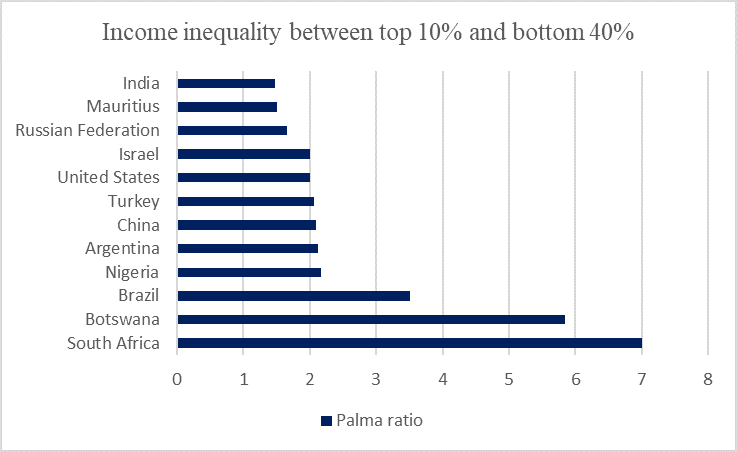
Other economic inequalities persist in SA. For instance, emphasis on wealth accumulation could be used to explain inequality of outcomes as a result of the disadvantaged starting point of poor people who are unable to build wealth as quickly as those who come from wealthy backgrounds leading to increasing wealth inequality. Figures 4 and 5 below highlight the unequal share of the country’s wealth with the gap increasing significantly over the years, and the wealthiest 1% of the population accumulating more than half of the nation’s wealth. This suggests that disproportionate opportunities have become intergenerational, with children of poor households less likely to get out of the poverty cycle.

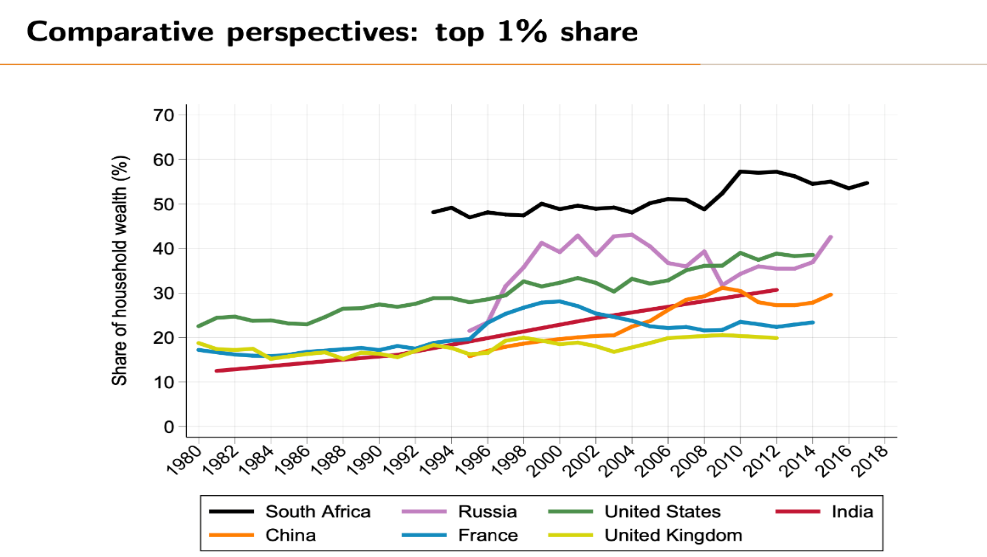
Multidimensional approach in tackling inequality
Inspite of the disparities shown above, the economic statistics mask the extent of inequalities that exist among the different groups on the income distribution scale, in terms of available opportunities. Economic inequality measurements tend to focus on average outcomes that may not be representative of the majority of a population’s size, thus leaving out the most vulnerable. These measurements are often unable to detect inequalities embedded in social structures that form the basis for disproportionate allocation of resources within a society. Consequently, it is imperative to assess and monitor inequality using a more comprehensive approach to reveal the various ways inequalities manifest and interact, the underlying factors that create and reinforce them, the impact on society at large and, most importantly, appropriate policies to tackle inequality from the root.
The stubborn nature of inequalities suffered by deprived groups in SA, even after decades of democratic rule, suggest that these groups have become trapped in an inequality web or cycle, passed down from generations. Inequality traps at group levels are more ingrained and harder to shake off. Therefore, analysing the multi dimensions of inequality relating to these traps provides a better understanding, and reveals undetected disadvantages faced by individuals and groups.
SA’s SDG 10 progress reports list unfavourable labour market outcomes related to uneven distribution of jobs and wage disparities, as a major direct cause of income inequality in South Africa. Figures 6a and 6b the unemployment rate for white citizens at 6.7% while unemployment amongst the black population stood at 31%, with females generally more affected than males. This has resulted in vulnerable groups having to depend more on social grants and less on income from the labour market.
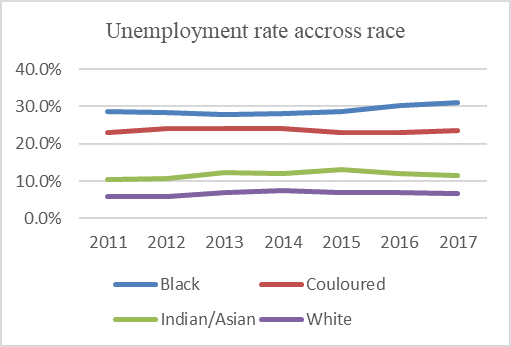
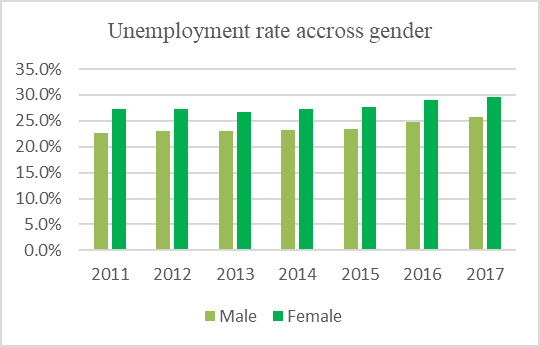
The economy has also undergone structural transformation with a decline in the primary sector (consisting of large numbers of unskilled or semi-skilled labour) and expansion of tertiary sector (comprising skilled labour). Demand for labour has thus shifted away from unskilled to more opportunities for the skilled. The prevailing poverty trap amongst historically disadvantaged groups in the country limits labour mobility of the unskilled workers from upscaling their skills, creating a shortage of skilled labour, thereby increasing the premium for skilled labour, often occupied by the privileged groups. In addition to experiencing unequal job opportunities, black citizens belong to the lowest wage band when in employment. Whites, by contrast, earn substantially higher wages than all the other population groups. From a gender perspective, female workers earn approximately a third less than male workers who tend to have better paying jobs. Figure 7 summarises the average monthly earnings across race, and exposes the level of wage disparity, with blacks earning only a third of white earnings.
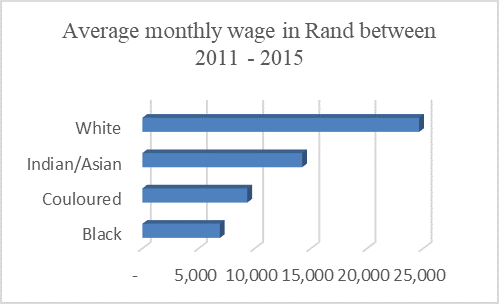
In addition, inequality of opportunity is particularly evident in accessing tertiary education in SA. Based on World Bank’s inequality assessment report, living in a household where the head has attained some tertiary education reduces the average risk of poverty by about 30%, thereby raising concerns regarding low-income families that lack easy access to education grants or credit facilities markets, and incur relatively high costs of sending a child to college. This serves as a major barrier to getting sufficient levels of education and relevant skills to actively participate actively in the labour market. Based on government policies, there are public institutions that provide free primary and secondary education and this has been instrumental in a surge in early school enrolment. However, it was not until quite recently that the government put in place a scheme to provide extremely poor households with free tertiary education. This scheme was a result of a nationwide protest tagged #FeesMustFall, with disadvantaged students demanding free higher education. Inspite of the positive steps taken by government, there is still a large proportion of the population who do not meet the criteria for financial aid, yet do not have sufficient funds to access premium higher education.
Opportunities relating to access to infrastructure are often influenced by geographical location. These include access to health care facilities and medical aid, clean water and sanitation, energy, among others. Children who grow up in informal settlements and rural communities face a distinct disadvantage. During apartheid, socially excluded groups were concentrated in the most disadvantaged locations called homelands, characterised by remote and challenging rural terrains or overcrowded slum neighbourhoods. The country’s poorest areas are within the provinces where the largest densities of these homelands were located. This demonstrates that spatial patterns of poverty have not necessarily shifted over time, as inequalities are startling in the very spaces where apartheid was most evident. Regional disparities within the market system also occur because better infrastructure tends to attract private investment and savings, thereby making the developed regions even more attractive for future investment. The intersection of the above multiple disadvantages, further deepens the extent of inequality.
Policy recommendations
Determining the nature and sources of inequality is critical in formulating effective policy measures to reverse the inequality trend. Transformative policies are required to ensure inclusion of the most vulnerable groups that suffer social and economic exclusion. The prolonged inequality traps experienced by deprived groups in South Africa suggest that the market mechanism alone is incapable of turning the tide. State intervention is therefore necessary in reversing the structural discriminations that have existed over time. These interventions should guarantee equal access, and improvement in the quality of social services provided to marginalised citizens. This may require increased budgetary allocations to higher education and skills acquisition schemes, medical aid, housing facilities, small businesses loans for business expansion and job creation, targeted at disadvantaged groups. Interventions that simultaneously stimulate national development and reduce inequalities are likely to be more effective.
Creating good jobs for the poor and expanding opportunities through acquisition of skills is an inclusive growth plan that would strengthen the social compact, build a vibrant middle class, positively impact national output and promote a sense of shared prosperity. This is a vital pillar towards achieving the country’s long-term objectives around improving citizen’s welfare. Inclusive growth strategies are essential in order to unlock growth and equally address inequality. Such strategies should merge social and economic policies, aimed at changing patterns of access to opportunities, and dismantling the categorisations that promote disproportionate allocation of resources and rights within the society. Reduction of income inequality should not be limited to redistribution through the fiscal policy or tax-transfer system alone, but should incorporate a realignment of the supply-side policies.
(Main image: A general view of Khayelitsha, near Cape Town, South Africa, on 31 March 2020. It is the city’s largest township, where hundreds of thousands live in shacks. – Rodger Bosch/AFP via Getty Images)
This article was first published on the University of Bath’s IPR blog. The opinions expressed in this article are those of the author(s) and do not necessarily reflect the views of SAIIA or CIGI.
